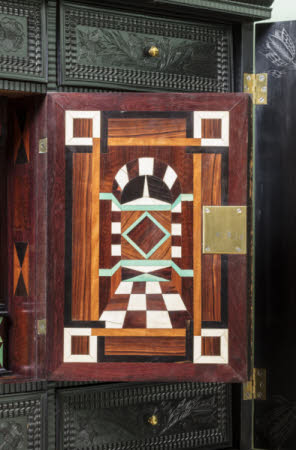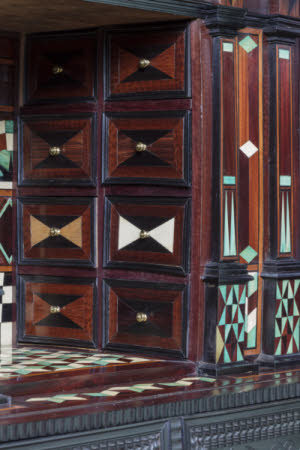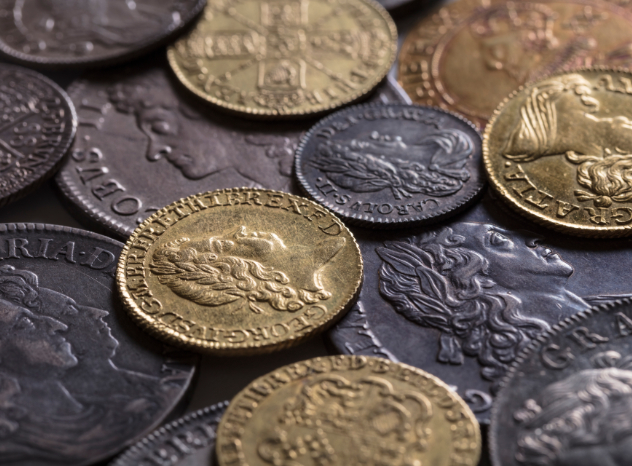Osterley Park's 'Elaborately carved Ebony cabinet on carved pillar Stand' - circa 1630
manner of Jean Macé (c.1602-72)
Category
Furniture
Date
circa 1630
Materials
Ebony, lime or poplar, oak, ebony, rosewood, brass, ivory and stained ivory, tortoiseshell
Measurements
186 x 162 x 59 cm overall; the cabinet 94 x 157 x 56cm; the stand 92 x 162 x 59cm
Place of origin
Paris
Order this imageCollection
Osterley Park and House, London
NT 771816
Summary
An ebony and ebony-veneered cabinet on stand, Paris, circa 1630, in the manner of Jean Macé (c.1602-72). The carcase of softwood and oak; the drawers incorporating lime or poplar. And having a cornice-like upper moulding above a cushion-fronted or convex long drawer, with rounded ends. All above a pair of cupboard doors, applied with ripple-moulded ebony mounts forming a cross. To the centre of each cross a roundel carved with cavorting putti. The remainder of the doors with reserves filled with trailing, naturalistic flowers, stalked and leaved, including tulips and roses. With base moulding. The stand topped by a moulding and fitted in the frieze with a pair of short drawers, both with floral carving matching the cupboard above. A conforiming pendant apron below the drawers. On eight columnar legs with collars spacing carved flowers. Joined all round by a flat, plain rectangular stretcher. Ripple-mouldings applied to the leg blocks. Later bun feet. To the centre of the cabinet's interior a pair of doors revealing an interior perspective scene of an archway or apse between pilasters and with a chequered, paved floor. Inlaid with ivory and green-stained ivory, exotic hardwoods, fruitwoods, ebony and with two panels of turtleshell. The rearmost panel of this section sliding to reveal an arrangement of multiple secret drawers. Fitted throughout with lacquered brass mounts, some engraved. The high quality main lock shooting three bolts.
Full description
Like the Japanese lacquer cabinet on stand (NT 771821) at Osterley, this cabinet on stand - made of ebony - pre-dates the rise of the Child family and the amassing of their spectacular fortune. How and when it was acquired we don't know. Nonetheless, the cabinet was at Osterley by 1782, when it was listed in 'Mr Child's Bed Chamber', a privileged position denoting its status as one of the family's treasures and heirlooms.[1] When it was made in Paris around 1630, this cabinet was both the product, and the embodiment, of European geo-politics, the influx of new and exotic materials into Europe, and the ideals of Europe’s fashionable elites. Designed to securely store and display small treasures, jewels, scientific instruments and natural curiosities, this type of cabinet was the heir of the room – called a studiolo – which first appeared in 15th century Italy and, later, in France (a cabinet) and in the Netherlands (a Kunstkammer) in the houses of wealthy families fashioning themselves as connoisseurs of the curious and the exotic, and as scholars. With this derivation, ownership of this type of cabinet demonstrated the wealth, erudition and taste of its owner. Made of ebony and other exotic materials, cabinets like this not only housed treasures, but were also treasures themselves. Ebony had been used in small quantities in the Medieval period to decorate small pieces of furniture like boxes and caskets. In the 1630s and 1640s, new trading routes opened by Dutch, Portuguese and French explorers into new territories like Madagascar, Reunion or Mauritius, where ebony was indigenous, facilitated the use of ebony in Europe in much larger quantities. Ebony held simultaneous ‘aesthetic and symbolic’ appeal. Hard, jet black and with a subtle sheen, it was not only beautiful, but was also prized by seventeenth century elites because the Bible and staple classical texts proclaimed it as prized by the kings and emperors of antiquity.[2] The greater supply of ebony in the 17th century coincided with, or was possibly the catalyst for, a sea-change in the way in which furniture was constructed and decorated in Europe. Until the end of the sixteenth century, most European furniture was made of planks of wood joined together and decorated with carving or paint, or with applied metal mounts and straps. In sixteenth century Italy and Germany, however, more advanced techniques developed, where thin sheets of exotic and expensive woods were glued to a carcase of less expensive timbers, in a process known as veneering. This, in turn, allowed for the development and spread of Italian intarsia, a technique involving the insertion of smaller pieces of timber sheets to be inlaid in decorative patterns. This cabinet was made in Paris by craftsmen familiar with these techniques, probably either a Netherlandish craftsman who had settled in France, or a French-born furniture-maker who had trained for a time in Holland. Thus, Dutchman Pierre Gole (c. 1620-84) settled in Paris in 1642 and was appointed cabinet-maker to the Louis XIV (1638-1715) in the 1650s, where he (and contemporaries like Jean de Milleville, Jacques Delbart and Laurent Septarbres) made furniture incorporating large quantities of ebony, contrasted by materials such as tortoiseshell, silver, bronze and hard stones. So closely was ebony associated with these new techniques that the profession in France still derives its name from the material, where a cabinet-maker is called an ébéniste: one of Gole’s titles was maître menuisier en ébène ordinaire du roi (‘master ebony furniture maker-in-ordinary to the King’). With several workshops producing veneered furniture in Paris around 1640, the Osterley cabinet is not unique, and others are in the collections of the Louvre (OA 6629), at the Musée National de Chateau at Fontainebleau (Inv. F806c), in the Rijksmuseum (RBK 16117), in the Musée National de la Renaissance (Inv. E.Cl.20476), the Musée des Beaux-Arts (Inv. CA T 920), in the Metropolitan Museum of Art, New York (Inv.31.66a,b) and in The Geffrye Museum (inv. 46, 1979). This cabinet is in the manner of Jean Macé (c.1602-72), who underwent his apprenticeship in Middelburg, the capital of Zeeland, circa 1620. He was appointed the ébéniste to Louis XIII in 1644. His daughter married Andre-Charles Boulle. The presence of these cabinets in some of the finest museum collections in the world is a testament to their quality and beauty. In fact, however, the Osterley cabinet is less opulent than most, with a reserved exterior relying for decorative effect on ripple mouldings forming geometric shapes, simply engraved stalked and leaved flowers and two relatively simple roundels carved with pairs of cavorting putti. The cabinet in the Louvre, which has been attributed to Gole, is altogether more opulent, entirely carved with figurative scenes. Its interior is highly decorated with a variety of materials, whilst the interior of the Osterley cabinet is fairly simple, veneered in rosewood (or a similar exotic hardwood) and inlaid with monochrome and stained ivory shapes. The closest comparables to the Osterley cabinet in England are at Knole (NT 129530), Arundel Castle, the Ashmolean and the Geffrye Museum. The latter, with similar mouldings and relatively simple engraved line carving, was purchased in Paris in 1652 for Francis Child I’s near contemporary, John Evelyn (1620-1706), by his wife, Mary (d. 1709) the daughter of the English ambassador to the French court. Ebony first appears in English rate books (books which record imports and the tariffs they incurred) in 1642 (when it was valued as the most expensive furniture wood of the period), a decade before the Evelyns purchased their cabinet in Paris. Ebony remained popular throughout the period when Francis Child’s business was flourishing, and his bank was founded. In 1660, the rate books valued it at the same price as in 1642, and it was used extensively not only in English furniture but in English clock cases and picture and mirror frames, until about 1690.[3] It is possible that Francis inherited the cabinet, either from his own family – the Childs of Heddington, Wiltshire – or from the City banking families of Blanchard and Wheeler, into which he married in 1671, but it is not beyond the bounds of possibility that he purchased (or acquired) it second-hand in the last quarter of the seventeenth century, when ebony was still fashionable. In 1697, Francis visited the Netherlands, and he may have acquired it there, albeit his diary shows that it was the Asian objects he saw there that struck him most forcibly.[4] Thereafter, ebony began to pass out of fashion in England. Possibly thanks to war with France in the 1690s, imports had fallen away sharply by 1710, and the desire for ebony was superseded by the influence of Dutch floral marquetry, and the introduction of walnut (lighter and more highly figured than ebony) as the principal furniture wood in England. Ebony only re-emerged in cabinet-making in Britain around 1800.[5] Megan Wheeler, October 2019 [1] Listed as ‘A large Ebony Cabinet’ in ‘Mr Child’s Bed Chamber’, in M. Tomlin, ‘The 1782 Inventory of Osterley Park’ in Furniture History XXII (1986), p. 116. [2] A. Bowett, Woods in British Furniture Making 1400-1900 (2012), 'Ebony' [3] Ibid. [4] Y. Sharma & P. Davies, 'A jaghire without a crime': The East India Company and the Indian Ocean material world at Osterley, 1700-1800', in East India Company at Home, 1757-1857, eds. M. Finn & K. Smith (2018), pp. 93-4. [5] Bowett, Woods, 'Ebony'.
Provenance
Listed in the inventory of goods at Osterley in 1782 in 'Mr Child's Bed Chamber' as 'A large Ebony Cabinet' and in 1871 'A 5ft Elaborately carved Ebony cabinet on carved pillar Stand w 2 drawers at top and brass fall handles, 2 folding doors enclosing - interior fittings of 12 drawers w brass - knobs and folding door Inlaid Ivory recess in Cabinet w one tray top drawer - and 20 small drawers w brass knobs - and escutcheons - lock and Key' in the State Bed Chamber. Thence by descent, until purchased from George Child-Villiers, 9th Earl of Jersey (1910-1998) by HM Government in 1949 for the Nation and vested in the Victoria and Albert Museum; transferred to the National Trust in 2002.
Marks and inscriptions
The top two drawers inscribed in ink and on the carcase of the cabinet '1' and '2'.
Makers and roles
manner of Jean Macé (c.1602-72), ébéniste
References
Tomlin, 1986: Maurice Tomlin. “The 1782 inventory of Osterley Park.” Furniture History 22 (1986): pp.107-134., 116 Bowett, Adam 'Woods in British Furniture Making 1400-1900' London 2012 Sharma, Y & Davies, P. (2018), 'A jaghire without a crime': The East India Company and the Indian Ocean material world at Osterley, 1700=1800', in East India Company at Home, 1757-1857, eds. M. Finn & K. Smith (2018), 93-4










